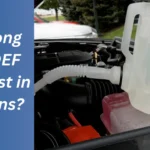To force a regen on a 6.7 Cummins, drive the vehicle at highway speeds for at least 30 minutes. This will increase exhaust temperatures and trigger the regeneration process.
The 6. 7 Cummins engine is known for its powerful performance and reliable durability. However, like any diesel engine, it requires periodic regeneration to maintain optimum efficiency. Regeneration is a process that removes particulate matter from the exhaust system, ensuring cleaner emissions.
While regeneration generally occurs automatically during normal driving conditions, there may be instances when a manual regen is necessary. We will discuss the simple steps to force a regen on a 6. 7 Cummins engine, helping you keep your vehicle running smoothly and efficiently.
Importance of Dpf in Emissions Management
The Diesel Particulate Filter (DPF) plays a crucial role in managing emissions in a 6.7 Cummins engine. The DPF is responsible for trapping and reducing harmful particulate matter from the exhaust gases, ensuring compliance with environmental regulations.
The DPF works by collecting soot and other particulates during normal engine operation. However, over time, the filter can become clogged and require regeneration to maintain engine health. Regeneration is the process of burning off the accumulated soot and restoring the filter’s efficiency.
Regeneration can occur passively or actively. Passive regeneration happens automatically during long drives at high speeds, where the exhaust temperatures are sufficient to burn off the trapped soot. However, for vehicles that mainly operate in stop-and-go city traffic, active regeneration may be necessary.
During active regeneration, the engine’s fuel injection timing is adjusted to increase exhaust temperatures and initiate the burning process. It is important to understand the signs of a necessary regeneration, such as warning lights or decreased engine performance, to prevent potential damage to the engine or DPF. Regular maintenance and keeping track of recommended service intervals help ensure the DPF’s optimal functionality and overall engine performance.
Identifying a Dpf Clog
Common symptoms that indicate a regen is necessary include dashboard indicators and warning messages. The dashboard indicators may vary depending on the model and year of the vehicle, but typically they will illuminate a warning light or display a message such as “DPF Regen Required” or “Clean Exhaust Filter.” These indicators are designed to alert the driver that the diesel particulate filter (DPF) is becoming clogged and needs to be regenerated.
When the DPF becomes clogged with soot and other particulate matter, it can cause a variety of performance issues with the engine, such as reduced power and decreased fuel efficiency. Some common symptoms of a clogged DPF include sluggish acceleration, excessive fuel consumption, and increased exhaust smoke.
If you notice any of these symptoms or receive a regen warning message, it is important to address the issue as soon as possible to prevent further damage to the engine or emissions system. Ignoring a DPF clog can lead to costly repairs and potential engine failure.
Manual Triggering Versus Automatic Processes
| Manual Triggering versus Automatic Processes |
| Forcing a regen on a 6.7 Cummins can be done either manually or through automatic processes. Dealing with a blocked diesel particulate filter (DPF). When the automatic regen process fails. In emergency situations where immediate action is required. To regain engine performance and prevent damage. Manual triggering allows you to take control and initiate the regeneration process manually, providing a solution. when automatic regen is not working effectively or in critical situations. By following the manufacturer’s recommendations and utilizing diagnostic tools, manual regen can help to resolve DPF blockage issues and prevent damage to the engine. It is important to note that manual regen should only be done by individuals with knowledge and experience in handling the Cummins regen process to avoid any potential risks or complications. |
Safe Practices Before Regeneration
Vehicle placement and environmental considerations: Before forcing a regeneration on your 6.7 Cummins engine, it is important to consider the placement of your vehicle and the surrounding environment. Park your vehicle on a flat and stable surface, away from anything that may present a fire hazard. Make sure the area is well-ventilated to prevent the buildup of harmful gases.
Engine state and preliminary checks: Before initiating a regeneration, ensure that your engine is at operating temperature. Check the coolant, oil, and DEF levels to make sure they are sufficient. Inspect the DPF system for any signs of damage or plugged filters. Address any issues before proceeding with the regeneration process.
Engaging in safe practices: before forcing a regeneration on your 6.7 Cummins engine is crucial to ensure both your safety and the proper functioning of the vehicle. By following these guidelines, you can minimize the risk of accidents and potential damage to your engine.
Initiating a Force Regen on the 6.7 Cummins
When it comes to regenerating the diesel particulate filter (DPF) on a 6.7 Cummins engine, there are certain steps you need to follow for a successful process. To begin, you will require a few tools or software: a diagnostic scanner compatible with Cummins engines, a laptop or tablet with the proper software, and an internet connection for potential software updates.
Once you have gathered the necessary tools, you can start the force regen process. First, connect the diagnostic scanner to the OBD-II port on the vehicle. Then, turn on the ignition and select the appropriate vehicle make, model, and engine. Access the DPF section in the software and look for an option to initiate a force regen.
If available, select the option and follow any prompts or instructions provided by the software. During the process, it is crucial to keep the engine running and to not interrupt the regen cycle. Monitor the software for any error codes or messages and take appropriate action, if necessary.
Key Observations During a Force Regen
To force a regen on a 6.7 Cummins, there are a few key observations to keep in mind. One of the most important aspects is monitoring the parameters throughout the process. By keeping an eye on specific parameters, you can identify any potential issues that may arise during the regeneration.
Some of the parameters to monitor include exhaust gas temperature (EGT), diesel particulate filter (DPF) pressure, and intake air temperature (IAT). A rise in EGT indicates that the regeneration process is starting. Monitoring DPF pressure helps determine the efficiency of the filter while the IAT reveals any abnormalities in the intake system.
Additionally, it’s important to monitor the duration of the regen process and the frequency of regens. By doing so, you can identify if there are any underlying issues that need to be addressed to ensure optimal functioning of the 6.7 Cummins.
Ensuring Dpf Longevity
Ensuring DPF Longevity Aftercare for the Cummins DPF system:
Regular maintenance of your 6.7 Cummins DPF system is crucial to avoid frequent regenerations. By sticking to a diligent maintenance schedule, you can extend the life of your DPF and enhance the efficiency of your engine. Here are some key practices to consider:
- Follow the manufacturer’s guidelines for routine maintenance and servicing. This includes regular oil changes and filter replacements.
- Utilize quality diesel fuel that meets the recommended specifications. Contaminated fuel can lead to clogged filters and increased regeneration frequency.
- Keep an eye on your vehicle’s exhaust system for any signs of damage or leaks. Addressing these issues promptly can prevent further damage to the DPF.
- Avoid prolonged idling, as it can contribute to excessive soot accumulation in the filter. Opt for shutting off the engine when parked for extended durations.
- Regularly monitor the dashboard indicator for any engine fault codes related to the DPF system. Addressing these codes promptly can prevent major issues.
- When needed, perform manual regeneration of the DPF system according to the manufacturer’s instructions. This can help clear any accumulated soot and restore optimal performance.
Remember, proper aftercare and maintenance of your Cummins DPF system can greatly contribute to its longevity and minimize the need for frequent regenerations.
When Force Regen on Cummins Doesn’t Work
When force regen on a 6.7 Cummins doesn’t work, it can be frustrating. However, there are common complications that can arise and solutions to try before seeking professional assistance. One common issue is a clogged or dirty diesel particulate filter (DPF).
If this is the case, a thorough cleaning or replacement may be necessary. Another complication could be a faulty sensor or malfunctioning system. Checking and replacing any faulty sensors or components can help resolve the issue.
Additionally, it’s important to ensure that the engine is at the correct operating temperature before attempting a force regen. If all else fails, it may be time to consult a professional who specializes in Cummins engines to diagnose and fix the problem.
FAQs for How To Force A Regen On A 6.7 Cummins
The frequency of regen cycles depends on your driving habits. Typically, it’s recommended to force a regen every 300-500 miles of highway driving or every 50 hours of idling.
Look out for indicators like reduced engine power, a noticeable drop in fuel efficiency, or the exhaust emitting a strong smell. If you spot these signs, it’s time to force a regen on your 6. 7 Cummins.
Yes, you can initiate a forced regen on your 6. 7 Cummins without a diagnostic tool. Simply follow the manufacturer’s instructions, which usually involve driving at a consistent speed for a set period of time to raise the exhaust temperatures and trigger the regeneration process.
Conclusion
Performing a forced regeneration on your 6. 7 Cummins engine is crucial for maintaining its optimal performance and longevity. By following the step-by-step instructions outlined in this blog post, you can effectively tackle any regeneration issues and prevent costly repairs down the line.
Take the necessary measures to keep your Cummins running smoothly and efficiently, ensuring a hassle-free driving experience. Keep your engine healthy and enjoy the power that a 6. 7 Cummins has to offer.




